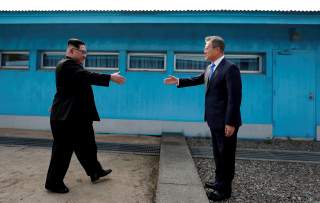A Korean Peace Treaty Would Create a Constitutional Crisis
A treaty would suggest, at least by implication, mutual recognition of the two Koreas by each other, which would create a constitutional problem for South Korea because it denies the existence of North Korea and claims sovereignty over the entire peninsula.
Women Cross DMZ Executive Director Christine Ahn recently argued that the rapprochement between President Donald Trump and North Korean supreme leader Kim Jong-un merited concluding the Korean War of the 1950s. That conflict was ended by an armistice, not a peace treaty. Legally, a state of war still exists.
It is an intriguing idea and one seemingly self-apparent. The two Koreas have not fought a major armed conflict since the war ended in 1953. Conventional deterrence on the peninsula has stable for decades. And nuclear deterrence, a new state between the United States and the North, is likely to be stable as well. Adapting to a nuclear North Korea is not a bad option among all the poor options for responding to Northern nuclearization and certainly superior to strikes, which could lead to a major war.
Unfortunately, there are two significant hurdles that have made it difficult for the Koreas to agree on a peace treaty.
First, strategically, the biggest problem is the continuing military standoff along the military demarcation line. North Korea continues to station about one million soldiers near Seoul. Treaty advocates argue that a termination of the war would allow the North to retrench, but without previous retrenchment, it is hard to imagine the South Korean and U.S. militaries—and national security communities—supporting a treaty. There is a thorny, chicken-or-the-egg problem of sequencing here.
Alternatively, if the treaty is signed and there is no strategic reposturing by either side, then the treaty is just a formality. It would probably be best, therefore, to wait until the actual strategic situation on the ground improves before closing a treaty. Only at that point will the treaty actually reflect changed realities.
The problem, I believe, is that treaty advocates often conceive of a treaty along the lines of a definitive war concluding moment, akin to the treaties which ended World War II. In 1945, Germany and Japan were clearly defeated, and their treaty surrenders recognized that reality. An inter-Korean treaty though would be more akin to that between the United States and North Vietnam in 1973. As in Korea, neither side was clearly beaten and their political goals in the conflict haven not changed that much. Hence, the treaty was more a freeze of hostilities than a final war termination act.
An inter-Korean treaty that leaves both Koreas fully intact with their militaries substantially unchanged would suffer from the same sorts of revisionist temptations as the Paris Peace Accords. In the years following the Paris deal, North Vietnam continued to harass South Vietnam until open hostilities broke out again. It would be easy to see North Korea, which has launched hundreds of provocations against South Korea since the war, doing the same. Indeed, one could also see a conservative government return to power in the South and declare the treaty void (discussed below).
In short, the major problem with a treaty is that it may put the cart before the horse. Deeper détente on the peninsula, including some kind of deal on the North’s nuclear weapons, is likely needed to provide the underpinning strategic improvements. Otherwise the treaty may just be yet another inter-Korean agreement which atrophies over time.
Second, politically, a treaty has all sorts of domestic ramifications in South Korea, which the government of President Moon Jae-in has yet to tackle. This is likely why the Moon government abandoned its 2018 push for a treaty and fell back to a vaguer “peace regime,” and then to an even vaguer “war-ending declaration.” The legal weight of these two alternate concepts is unclear.
One obvious political hurdle is the implacable opposition of the South Korean Right to détente with North Korea. I have mentioned this issue in the past. The Moon government has run its North Korea outreach with little effort to recruit center-right opinion. But Moon only won the presidency with 41 percent of the vote. Without some conservative acceptance of a peace treaty, there is a fair chance that the next time the South Korean right wins the presidency, it will undo the treaty. In fact, this is a threat to the entire Moon program on North Korea, and it has happened before. From 1998 to 2008, the South Korean Left, holding the presidency, pursued a “Sunshine Policy” with North Korea. The domestic Right was not brought into that effort, and on the return of a conservative to the South Korean presidency in 2008, that conservative president, Lee Myung-bak, rolled back the Sunshine Policy. This could happen again to Moon.
The other big political problem with a treaty is the constitution of South Korea, which denies the existence of North Korea and claims sovereignty over the entire peninsula. A treaty would suggest, at least by implication, mutual recognition of the two Koreas by each other. It is not entirely clear how big this hurdle could be. I have spoken to this point at several conferences here in South Korea and have heard mixed responses. Some people seem to think that may be a way to legally kludge around the constitution. Others have suggested that Moon would have to change the constitution to pursue a formal treaty; hence, the idea of a “peace regime” or a “war-ending declaration” is the path of least political resistance.
A peace treaty is an intriguing idea. If Trump, Moon, and Kim can change facts on the ground enough to warrant it, then it is probably worth trying. But the politics may not be there yet.
Robert E. Kelly is a professor of international relations in the Department of Political Science and Diplomacy at Pusan National University. More of his work may be found at his website,AsianSecurityBlog.wordpress.com.
Image: Reuters

